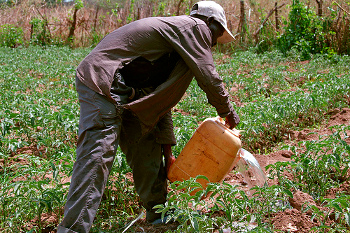Engineering For Change in their information related to Water have done a great post on ten different low tech methods of irrigation. In the Vidharba area where we work – irrigation is largely done by sprinkler systems – one of the most water wasteful methods as much of this water evaporates and does not reach the target root systems. Also this irrigation is done in the middle of the day when the temperature is high because the supply of the Government subsidised electricity used for the pumping systems is most available at that time, therefore markedly increasing the rate of evaporation.
Of the ten low-tech ways to irrigate probably the most efficient is drip irrigation – especially the gravity fed systems. Using treadle pumps like those discussed by Paul Polak in his book Out of Povery and the iDE Organisation
It is vital to educate and assist the small farmers to understand the benefits they will gain very quickly through using these grass roots methods of irrigation.

Watering and flooding fields by hand is simple, cheap and hard work, but leveling the field can help conserve water. Photo by Bread for the World / Flickr
Flood irrigation
Flooding fields with water from buckets or pumps is one of the simplest methods of irrigation. The advantage is that it requires little energy or equipment. Done improperly, however, it can waste water and erode and salinize the soil. Engineering for Change
With these simple methods of irrigation promoted widely farmers can increase their crops, save water and improve their lives.
When we build dams and other water harvesting structures – this information must be brought to their attention in a clear – respectful manner – that can help them to understand the benefits and gains of their investment.

